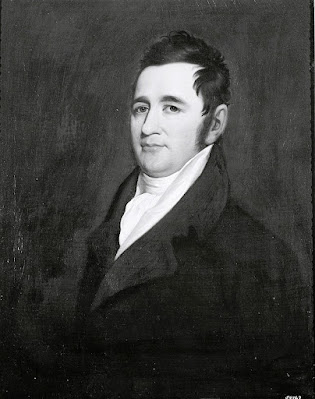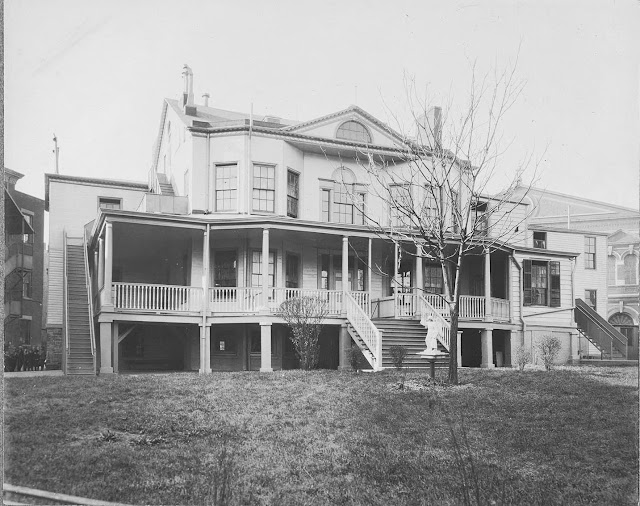William Rickarby Miller painted this watercolor of the mansion in 1855, decades before alterations were made. (original source unknown)
The first Prime to arrive in America, Mark Prime, helped settle Rowley, Massachusetts, where he died in 1683. Five generations later, in 1768, Nathaniel Prime was born, the fourteenth of fifteen children of Joshua and Bridget Hammond Prime. The 1898 Prominent Families of New York said, "He was settled in New York before the close of the eighteenth century, and became one of the greatest merchants and bankers of that period."
More specifically, Prime relocated to New York City in 1795 and a year later opened an office on Wall Street, listing himself as "stock and commission broker." In 1808 he partnered with Samuel Ward III to form Prime & Ward.
Nathaniel Prime married Cornelia Sands on June 7, 1797. The couple would have six children. They moved into the former Kennedy mansion at 1 Broadway. At the time, wealthy families maintained summer estates in the upper portions of Manhattan, most of them close to the cooling breezes of the East or Hudson Rivers. In 1800 Prime purchased 24 acres of land "near Hurlgate," as described by The Spur decades later, the area most often called Hell Gate.
The Primes' summer home reflected several of the Georgian architectural details of their townhouse--a second floor Palladian window surmounted by a half-round attic window, for instance. A full-width veranda caught the river breezes. Delicate foliate bands ran below the dentiled cornice and pediment.
The rear of the mansion was only slightly less impressive than the front. Orphans crowd the second floor balcony in this photo. from the collection of the Frank Cousins Collection of the NYC Public Design Commission.
The Primes were neighbors with wealthy families like the John Jacob Astors (whose summer estate Hellgate took its name from the area), Robert Lenox, and Stephen Whitney. All of their estates were soon threatened by the relentless northward expansion of the city. The families joined forces in 1827 when the city proposed to open 86th Street. According to his 1972 book Origins and History of the Village of Yorkville in the City of New York, among Prime's neighbors to sign a petition were Mary Waldron, Joseph Foulke, Phillip Rhinelander, "and, although they did not sign the petition, John Jacob Astor, Commodore Chauncey and others," opposed the work.
It read in part:
The land on each side is attached to country estates not contemplated to be sold in lots and the proprietors do consider it would be an actual injury to them. While they would be heavily assessed for it and any improvement, they also show that there are valuable stone walls on each side of the road and some buildings of considerable value to be taken down which will make the assessment very heavy without any material advantage at least for many years to the public.
The push worked, at least for a while, and the estates remained unmolested. In its January 1835 issue, The American Gardener's Magazine described the Primes' gardens and "forcing houses" where produce was grown, saying, "This place is well known, as containing one of the finest ranges of forcing houses in the vicinity of New York. These have been built within a few years and the vines, peaches, &c. planted in them, have just come into bearing." The journalist wrote, "We never observed grapes which set finer, at this early season of the year; the peach trees were also covered with fruit; so much so that they would need thinning out." The article went on to explain, "Mr. Prime has a large cistern in front of his range, from which water is supplied of the green-house, forcing houses, and to all parts of the garden." In closing, the writer noted, "The views of the surrounding scenery, from Mr. Prime's pleasure ground, in the summer, is said to be delightful."
At the time of the article, according to Prominent Families of New York, Nathaniel Prime "was rated as one of the five richest men in America." He had essentially retired from active business at the time, and moved permanently to the Hell Gate estate. It was a decision that, in the opinion of the American a few years later, would lead to his death.
Prime, described by The Spur as "stout, thick, short and heavy of build, but a wonderfully shrewd calculator," had become despondent in the fall of 1840. His condition was serious enough that on November 22 Cornelia called Dr. Edward Delafield to the house. She told him her husband was "very altered" and "seemed to be under great melancholy." Prime told the physician that "he looked at things in a gloomy manner, for which he could not account, as he was perfectly easy in his circumstances." Delafield diagnosed him with "blood to the head, for which I have occasionally bled him," he later told the Morning Herald.
On the morning of November 26, Prime told Cornelia he was going into town. Those who interacted with him there said he was "well apparently, and cheerful," as reported by the American. He arrived home at around 1:00 and had luncheon with Cornelia. The Morning Herald reported, "At 2 o'clock...he withdrew from the dining table, and retired to his bedroom." He took a book with him and told Cornelia he was going to rest for awhile.
Thirty minutes later she entered the bedroom. The Morning Herald related:
Upon examining the apartment it appeared that he had laid upon the bed--that he had taken his coat and cravat off, and that he had been reading his prayer book--it was found open either on or near the bed, and his spectacles lying near it. He had evidently risen from the bed, taken a razor, placed himself before small looking glass, at which he was accustomed to shave, and there cut his throat, after doing which he went into another room, laid the razor down and fell upon the floor, on the spot where he was found by Mrs. Prime.
Dr. Delafield opined "he committed the act under a temporary derangement of intellect," and the coroner's jury decided he "put an end to his own existence, in a temporary fit of mental alienation, produced by bodily indisposition." The American had its own explanation, blaming Prime's retirement. "The want of its accustomed work may possibly have caused the mind to prey upon itself." The newspaper said Prime's shocking death offered an important lesson: "Never to abandon the mental or other pursuits that may have contributed to your rise in life--stick to this oar till you go down, and you will go down in good temper, and like a man."
Cornelia would live until 1852, but she almost immediately left the mansion. She most likely moved into Lane Cottage on the property, where her son Rufus was living. The main house became home to wealthy attorney Richard Milford Blatchford.
Born in 1798, Blatchford married Julia Ann Mumford in 1857. The couple had five children. An influential attorney, successful businessman, and close associate of William H. Seward, he was intimate friends with important figures like Daniel Webster and former mayor Philip Hone.
Richard Milford Blatchford, A Genealogical Record of the Family of Rev. Samuel Blatchford D. D., 1912 (copyright expired)
On October 9, 1844, Philip Hone wrote in his diary, "I went yesterday to dine at Mr. Blatchford's, at Hell Gate. The party consisted of old Mr. J. J. Astor and his train bearer and prime minster, Mr. Coggeswell; Mr. Dandon, Ole Ball, the celebrated Norwegian violinist (we used to call it fiddler), and myself." Hone stayed overnight. He continued:
When I arose this morning I contemplated the enchanting scene: the clumps of fine old trees, clothed in the gorgeous foliage of autumn; the lawn, still bright and green; the rapid waters of Hell Gate, covered with sailing vessels and steamboats--all combined to present a picture of consummate beauty. In this place, so rich in the beauties of art and nature, in the enjoyment of pecuniary independence, and happy in his family relations, did the former proprietor (Mr. Prime) commit suicide.
The Blatchfords' townhouse was at 6 East 14th Street in the fashionable Fifth Avenue neighborhood. There on December 23, 1857 Julia Ann Blatchford died. Three years later, on November 8, 1860, Richard M. Blatchford married Angelica Hamilton. Sadly, she died two days after their eighth anniversary, on November 10, 1868.
It was about this time that Blatchford sold the Hell Gate mansion and the block surrounding it to the Sisters of Notre Dame and purchased a summer estate in Newport.
He would marry one more time. On January 18, 1870 he married Katharine Hone, the daughter of his good friend. It was at the Newport estate that he died on September 4, 1875.
At the time of his death, the district known as Hell Gate was fully developed. The Sisters of Notre Dame used the former Prime block--once admired for its blooming gardens and fruit trees--as the site of St. Joseph's Orphan Asylum. On August 17, 1887, the New York Dispatch noted that the orphanage, "supports, educates and employs orphans and homeless and neglected children, especially of German birth, until the age of sixteen, when they are set to work to take care of themselves."
The Sisters of Notre Dame placed an angel statue in the yard, and fire stairs on either side of the house. from the collection of the Frank Cousins Collection of the NYC Public Design Commission.
In 1909, the Historical Guide to the City of New York mentioned that despite the mansion's current use, "some of its old fireplaces and mantels are preserved and from its upper balcony is obtained a fine view of Hell Gate." The Edison Monthly recalled the building's origins in an article titled "Yorkville Days" in June 1916. "The country house, which looks across Hell Gate, is a model for suburban homesteads, with broad verandas at front, sides, and rear sheltering its rooms from sun and wind."
But the end of the line for the venerable Prime mansion was on the near horizon at the time of the article. On July 21, 1918, The New York Times reported, "One of the most important developments in the upper Yorkville district that has been undertaken for many years is now in progress on the entire block bounded by First Avenue, Avenue A, Eighty-ninth Street, and Ninetieth Street." The article explained that the Sisters of Notre Dame realized their work could be "more economically and satisfactorily carried on outside of the city limits." It also pointed out the massive increase in value the block had seen in the 50 years since the property was purchased.
The Prime mansion, seen here heavily altered around 1900, was among the last surviving summer homes in the neighborhood. from the collection of the Museum of the City of New York
The buildings on the block were razed and replaced with modern structures.
no permission to reuse the content of this blog has been granted to LaptrinhX.com







.png)

Blatchford’s law firm evolved into Cravath, Swaine & Moore.
ReplyDeleteBlatchford’s sister Julia Maria married one of Bishop Henry Codman Potter’s brothers, Edward Tuckerman Potter, whilst Blatchford’s sister Sophia Ethelinda (aka Linda) became the guardian of Pauline de Rothschild’s father, aunt, and uncle.
ReplyDeleteAnd Angelica Hamilton was a granddaughter of Alexander Hamilton.
ReplyDeleteFascinating previously unknown (to me) NYC history!
ReplyDeleteHis son Edward was the President of the NYSE https://en.wikipedia.org/wiki/Edward_Prime
ReplyDelete